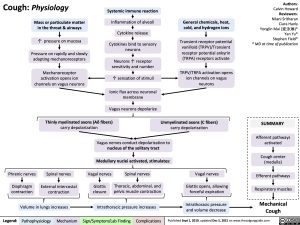Cough: Physiology
Mass or particulate matter
in the throat & airways
↑ pressure on mucosa Pressure on rapidly and slowly
adapting mechanoreceptors
Mechanoreceptor activation opens ion channels on vagus neurons
Authors: Calvin Howard Reviewers: Nilani Sritharan Ciara Hanly Yonglin Mai (麦泳琳)* Yan Yu* Stephen Field* * MD at time of publication
Systemic immune reaction
Inflammation of alveoli Cytokine release
Cytokines bind to sensory neurons
Neurons ↑ receptor sensitivity and number
↑ sensation of stimuli Ionic flux across neuronal
membrane
Vagus neurons depolarize
Thinly myelinated axons (Aδ fibers)
General chemicals, heat, cold, and hydrogen ions
Transient receptor potential vanilloid (TRPV)/Transient receptor potential ankyrin (TRPA) receptors activate
TRPV/TRPA activation opens ion channels on vagus neurons
Unmyelinated axons (C fibers)
carry depolarization
Vagus nerves conduct depolarization to
carry depolarization
SUMMARY
Afferent pathways activated
Cough center (medulla)
Efferent pathways Respiratory muscles
nucleus of the solitary tract
Medullary nuclei activated, stimulates:
Phrenic nerves
Diaphragm contraction
Spinal nerves
External intercostal contraction
Vagal nerves
Glottis closure
Spinal nerves
Thoracic, abdominal, and pelvic muscle contraction
Vagal nerves
Glottis opens, allowing forceful expiration
Intrathoracic pressure and volume decrease
Volume in lungs increases
Intrathoracic pressure increases
Mechanical Cough
Legend:
Pathophysiology
Mechanism
Sign/Symptom/Lab Finding
Complications
Published Sept 1, 2019, updated Dec 5, 2021 on www.thecalgaryguide.com

